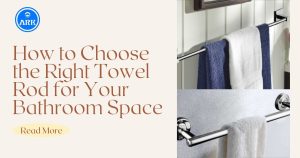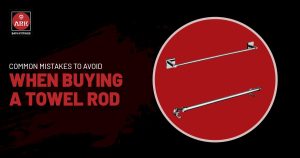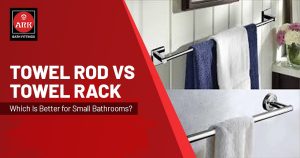In the world of plumbing, it’s often the smallest components that play the biggest roles. One such overlooked but essential part is the waste coupling. It acts as the link between your basin or sink and the drainage system, ensuring that wastewater flows away cleanly and efficiently.
This fitting may not grab attention during a remodel, but choosing the right one can make a big difference in how your bathroom or kitchen functions on a daily basis. This guide breaks down its purpose, variations, and how to make the right pick for your space.
What Does a Waste Coupling Do?
A waste coupling is installed at the drain hole of a sink or washbasin and serves as the point where wastewater exits into the drainage system. It’s also the first line of defence against blockages—keeping out debris, hair, and food particles depending on where it’s used.
More than just a connector, it helps:
- Prevent foul odours from backing up into your space
- Maintain a leak-proof seal
- Blend with the fixture’s design aesthetics
Read more: Everything You Should Know Before Buying a Waste Coupling Online
What Makes It Different in Bathrooms vs. Kitchens?
In Bathrooms:
Bathrooms use waste couplings in basins, where water usage is relatively low and mostly soap-based. The coupling here may need to match the basin’s design and sometimes accommodate an overflow channel.
- Often designed for slower water flow
- Pop-up models are common to allow water retention for shaving or face-washing
- Finish matters—chrome or matte black couplings often match bathroom aesthetics
In Kitchens:
Kitchens are a tougher environment for a waste coupling. Sinks see hot water, food waste, grease, and detergent. This means couplings here need to be more durable and wider.
- Typically fixed types for uninterrupted drainage
- Must be robust and rust-resistant
- Some include mesh trays to trap large bits of food
Does the Type of Waste Coupling Matter?
Yes—choosing the wrong type can cause everyday frustrations or even plumbing issues down the line. A mismatch can result in:
- Water not draining fast enough
- Loose fittings that allow leaks
- Clogs due to ineffective strainers
- Compatibility issues with bottle traps or overflow systems
The design of your sink or basin, your usage habits, and even the aesthetic finish you want can all influence which waste coupling is best for you.
Read more: Top 10 Waste Coupling Options for Kitchen and Bathroom Sinks
How to Choose the Right Waste Coupling
Before buying one, answer these key questions:
What kind of sink or basin do you have?
A designer countertop basin might require a visually appealing pop-up coupling, while a utility sink needs a simple fixed model.
Is there an overflow outlet in your basin?
If yes, pick a coupling designed to connect to it.
Do you need to retain water sometimes?
A pop-up style lets you block the drain temporarily.
Are you matching it with other fittings?
Couplings now come in varied finishes like gold, matte black, and antique bronze.
Is it for a bathroom or kitchen?
Kitchens need stronger, corrosion-resistant materials due to heavy use.
Read more: Waste Coupling: What It Is, Types, and How to Choose the Right One
Top 5 Considerations When Buying a Waste Coupling
1. Material
Look for couplings made from solid brass or SS304-grade stainless steel. These resist rust and last longer in wet environments.
2. Size Matters
Bathroom basins usually need 1.25-inch couplings; kitchen sinks often use 1.5-inch ones. Always measure your drain opening before purchasing.
3. Ease of Cleaning
Opt for a design with a detachable strainer or cover so you can clean out trapped waste quickly.
4. Water Flow Rate
Ensure the design doesn’t restrict water drainage. Kitchens especially require wide outlets for heavy flow.
5. Visual Appeal
In visible areas like wash basins, a polished or coloured finish can tie your decor together neatly.
Can a Homeowner Replace a Waste Coupling Without a Plumber?
Yes, but with some caution. Replacing a waste coupling isn’t the most complex plumbing job, but it does require a basic understanding of tools and sealing methods.
Here’s when a homeowner can do it:
- The existing coupling is loose or rusty but accessible
- You have a basic toolkit (spanner, plumber’s putty or Teflon tape, wrench)
- You’re dealing with exposed, standard plumbing—not concealed or custom installations
However, it’s best to call a plumber if:
- The coupling is fused or corroded
- The area is concealed behind cabinetry or tiles
- It needs to be connected to a bottle trap or overflow pipe
Incorrect installation can cause leaks or odour problems, so unless you’re confident, professional help is a safer bet.
Choosing the right waste coupling doesn’t just make installation easier—it ensures your bathroom or kitchen runs smoothly every single day. From water flow to aesthetics, the right choice blends function and form in one tiny package.
If you’re a homeowner, taking the time to understand your needs and your sink’s layout can prevent future plumbing headaches. If you’re a plumber, recommending the correct product builds long-term trust with your clients.
Remember, a well-chosen coupling isn’t just a drain—it’s the silent workhorse that keeps your space clean, efficient, and hassle-free.
Read more: Can Sensor Taps Work Without Electricity?












